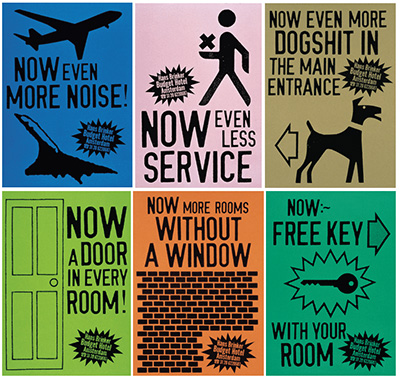I’ve just arrived home from Content Marketing World 2015, the largest conference for content marketers. After several days of learning, networking and, admittedly, commiserating with my peers, I feel fired-up to make some changes to our content strategy. (Or is this just extreme exhaustion setting in?)
Instead of opening my overflowing inbox—and suddenly putting the wonderful notes I took at CMW on the shelf to collect dust while I gently sob—I’m going to make some bold declarations. (Yep, I totally haven’t had enough sleep…)
I will hold myself accountable for putting what I’ve learned into practice NOW. And since I’ve put it in writing, I have to do it. (Unless my boss never reads this post…)
Here’s a few vital takeaways from several awesome speakers that I plan to implement ASAP.
1. Be insanely honest
 Doug Kessler, co-founder and creative director of Velocity, suggested in his incredibly refreshing session How Insane Honesty Can Take Your B2B Story to the Next Level, that marketers need to forget about trying to hide their product’s flaws.
Doug Kessler, co-founder and creative director of Velocity, suggested in his incredibly refreshing session How Insane Honesty Can Take Your B2B Story to the Next Level, that marketers need to forget about trying to hide their product’s flaws.
In fact, he argues that alienating some prospective customers is good. It will save your sales team time chasing down the wrong people. “Marketing should be thought of as a filter, not a magnet,” he says.
Take Hans Brinker, a budget hotel chain in Amsterdam that decided to get real honest in their advertising:



These ads do a pretty good job of scaring away potential customers who are looking for family-friendly (or clean and comfortable) hotel accommodations. And that suits the brand just fine since it isn’t the market they’re after.
No matter your industry, Doug recommends openly talking about which aspects of your product aren’t as strong as they could be (or at least not trying to hide it). Doing this shows buyers that you’re confident in what your product is really good at.
He also encourages giving competitors credit when it is due, since it shows you don’t feel they’re a threat. You can often find ways to benefit when a similar product or solution gets press, too.
While this will likely make your VP/CMO/CEO break out in a nervous sweat, try to imagine how refreshing this kind of honesty will be in the sales process. No one likes to be oversold, and your customer success team doesn’t want your clients to leave if they’re unsatisfied.
This kind of humour and authenticity has often worked for us at Influitive. But maybe when you’re pitching this idea, don’t show your boss the Hans Brinker ads as an example…(I really hope my VP stopped reading after the introduction.)
2. Prove the value of content
My performance is already measured against the inquiries I generate from our blog content and number of subscribers that sign up for our newsletter. (Shameless plug: sign up on the right side at the top of this page. You can’t miss it.)
 However, content can do so much more than generate clicks or shares. Rebecca Lieb, former analyst at Altimeter Group, shared some Less-than-obvious Content Metrics You Need to Pay Attention To that could help prove the ROI of your content marketing efforts. To show business value, look for opportunities to prove:
However, content can do so much more than generate clicks or shares. Rebecca Lieb, former analyst at Altimeter Group, shared some Less-than-obvious Content Metrics You Need to Pay Attention To that could help prove the ROI of your content marketing efforts. To show business value, look for opportunities to prove:
1. Cost savings. If you create a blog post to answer a common customer question, your content may circumvent support calls and emails.
2. Operational optimization. Tie your efforts to generating user generated content, which saves you time. Don’t forget about internal content; if your blog engages employees, or some of your documentation saves your coworkers time, that’s a win the higher-ups should know about.
3. Revenue generation. Aside from attributing closed deals to content assets through your CRM, find ways to measure how content is influencing loyalty, retention and upsell/cross-sell opportunities. If your content consistently delights customers, and turns them in the vocal advocates for your brand, tie that WOM to your efforts.
“If you don’t measure it, you won’t know,” says Rebecca. I’m going to investigate if it’s possible to track these metrics to show that our content does more than drive likes and retweets.
3. Do more with less (because It’s All Been Done*)
 We all know we should reuse and refresh our old content. But before I attended 101 Ways to Repurpose Content with Amy Higgins, Sr. Manager of Social Media for Zendesk, I can honestly say I don’t remember the last time I turned a blog into an infographic or made a social media image from a stat…
We all know we should reuse and refresh our old content. But before I attended 101 Ways to Repurpose Content with Amy Higgins, Sr. Manager of Social Media for Zendesk, I can honestly say I don’t remember the last time I turned a blog into an infographic or made a social media image from a stat…
Amy inspired me to go beyond chopping up an ebook into a blog post or two and calling it a day. She shared examples of how to break down large content assets (we’re talking monumental, all-encompassing guides that take months to make) into smaller ones, like ebooks, blogs, white papers, infographics, Slideshares, social media graphics, and even new nurture tracks.
 Not only can it save time and effort, but it can keep you focused on your content strategy. It’s hard to focus on repurposing when there’s constant pressure to always be creating something new. But that model isn’t scalable or practical. More doesn’t equal better. As Jay Acunzo, VP of Platform at NextView Ventures, said in one of his sessions, “If something succeeds, don’t repeat it. Do more with it!” He recommends morphing popular content into webinars, videos or a podcast.
Not only can it save time and effort, but it can keep you focused on your content strategy. It’s hard to focus on repurposing when there’s constant pressure to always be creating something new. But that model isn’t scalable or practical. More doesn’t equal better. As Jay Acunzo, VP of Platform at NextView Ventures, said in one of his sessions, “If something succeeds, don’t repeat it. Do more with it!” He recommends morphing popular content into webinars, videos or a podcast.
Now I’m planning to set aside time (and keep my poor graphic designer busy) to make our content go the extra mile.
What are you itching to try after leaving Content Marketing World ’15?
*P.S. For those of you who got the Barenaked Ladies reference, the show during CMW was awesome! They were honest, funny and repurposed all of their old songs—content marketing at its finest. Enjoy this flashback to ’90s music videos!












































